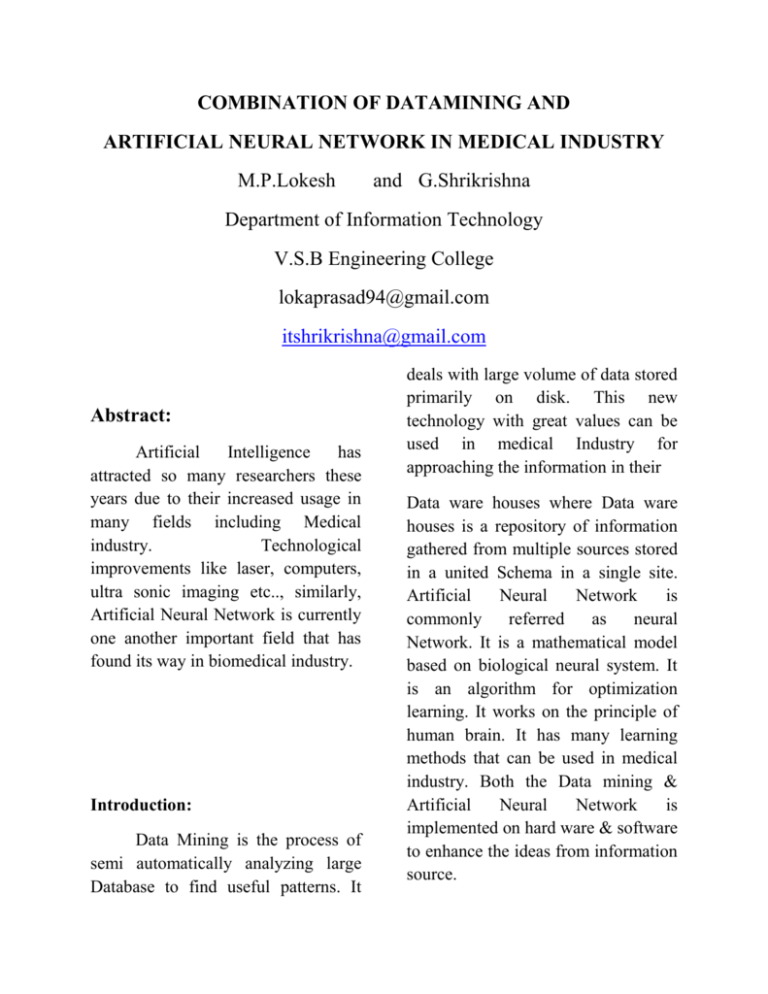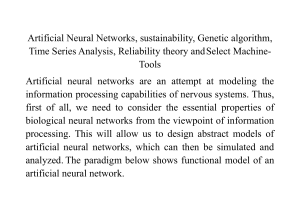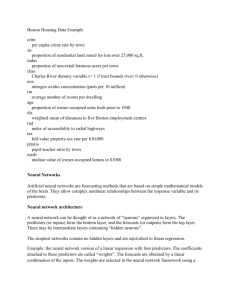File - OZ! THE GREAT
advertisement

COMBINATION OF DATAMINING AND ARTIFICIAL NEURAL NETWORK IN MEDICAL INDUSTRY M.P.Lokesh and G.Shrikrishna Department of Information Technology V.S.B Engineering College lokaprasad94@gmail.com itshrikrishna@gmail.com Abstract: Artificial Intelligence has attracted so many researchers these years due to their increased usage in many fields including Medical industry. Technological improvements like laser, computers, ultra sonic imaging etc.., similarly, Artificial Neural Network is currently one another important field that has found its way in biomedical industry. Introduction: Data Mining is the process of semi automatically analyzing large Database to find useful patterns. It deals with large volume of data stored primarily on disk. This new technology with great values can be used in medical Industry for approaching the information in their Data ware houses where Data ware houses is a repository of information gathered from multiple sources stored in a united Schema in a single site. Artificial Neural Network is commonly referred as neural Network. It is a mathematical model based on biological neural system. It is an algorithm for optimization learning. It works on the principle of human brain. It has many learning methods that can be used in medical industry. Both the Data mining & Artificial Neural Network is implemented on hard ware & software to enhance the ideas from information source. Approaches Data Mining: Data Mining can be approached through various methods. Association Rule: Decision tree can be used to represent decision making and represent decision. In Data mining Decision tree represents the Data. Artificial Neural Network: By this rule it checks for the relationship among the items. The rule has the form XY. X&Y are sets of items that do not intersect. It has two measurements support and confidence where support measure what fraction of population satisfies both confidence measures how often the consequence is true. Decision tree learning: It is a predictive model which maps observations about an item. The Decision tree can also be called classification tree or regression tree. The tree has its leaf nodes and the branches specify the relationship between them. Leaf node The brain is a highly complex component that can organize the structural constituents known as neurons to perform operations many times faster than the digital computer. Hence Artificial Neural Network is a model that works like the train to complete operations in high speed similar to the real Neurons. Scholars say A Neural network is a massively parallel distributed processor made up of simple processing unit: 1. Knowledge is acquired by the natural form through a learning process. 2. Into neuron connection strengths known as synaptic weights used to store the acquired data. branches Input N Input N Hidden layer N output layer N Fig.1 Structure of Decision tree Input N Input N N Output Fig2. Neural network. Neural Network architecture: It can be viewed as a weighted graph. Where the neurons are nodes and directed edges represent connection between neurons. Single layered Network: feed forward It is a layered Neuron Network where neurons are organized in the form of layers. The input layer of source projects to an output layer of neurons but not in vice versa. Hence this network is strictly a feed forward. Multi layered feed forward: They have one or more hidden layers whose computations nodes are correspondingly called hidden neurons. It is used to interfere between the external input & net work output in useful manner. Recurrent Network: It has at least one feedback loop. It consists of single layer of neurons with each neuron feeding its output signal back to the input of all neurons. Training Neural Networks: Supervised learning: It has an external teacher By that each output unit has a reason ho input signals. During the learning process global information may be required. Its important issue is the problem of error convergence. That is the minimization of error between desired and computed unit values. Unsupervised learning: It uses no external teacher. It is based only on local information. It itself organizes the data presented to the network and detects their collective properties. Data Mining based on Neural Network: They are non linear statistical Data Modeling tools. They used to model the complex relationship between input & output to find patterns in data. Using Neural Network as a tool Data ware housing firms are harvesting information from data sets in the process known as Data mining. The difference between data ware house & ordinary data bases is that there is actual manipulation & cross fertilization of data helping user to make more informed decisions. Data Data Target data Source Result Preprocess Data Expression Information Mining preprocess data fig3. Data Mining without Neural Network Original datadata preparing Rule extracting Useful RulesRule assessment Fig4. Data Mining based on Neural Network Genetic Engineering: It is a search that mimics the process of natural evolution. It is routinely used to generate useful solution to optimization & search problems. It belongs to the larges class of evolutionally algorithms which genetic solutions to optimization problem using techniques inspired by natural evolution such as Inheritance, mutation, selection, crossover. There are attempts to combine Genetic Engineering and Neural Networks. Given Five Components, Genetic Algorithm according to these steps operates 1. The population is initialized, using the procedure in C3. The result of initialization is as determined in C2. 2. Each member of the population is evaluated using the function in C1. 3. The population under goes reproduction until a stopping criterion. a) One or more parents are chosen to reproduce. Parents with high evaluation are favored. The parameters of C5 can influence the selection. b) The operators of C4 are applied to the parents to produce children. c) The children are evaluated and inserted into the population Decision Tree Learning is mostly used in statistics, data mining and machine learning. Training data Build tree by applying C4 operator to parents & produce children. Initial population Fitness evaluation Replace population Optional decision tree Term Yes Selection of individual Cross over 2. Evaluation function 3. Initialization procedure 4. Operators Mutation Cross over Gradient Mutation: A Mutation operator takes on parent and randomly changes some of the entries in its chromosome to create a child. Crossover: It takes two parent and genes one or two children unbinding some genetic of each parent. Gradient: A Gradient operator takes one parent and produces a child by adding to its entries a multiple of the gradient with respect to evaluation function. Genetic Algorithm (GA) Procedure Mutation (operator applied) Fig5. Decision Tree Our Genetic Algorithm 1. Chromosome Encoding Procedure GA Begin Initialize population; Evaluate termination condition not satisfied do Begin Select parents from current population; Apply genetic operators to selected Parents; Evaluate off spring equal to current population; End End The next generation starts as follows: 1. Choose individuals according to rank selection method. 2. Use two point crossover to exchange genes 3. Perform a bit level mutation to each off spring 4. Keep parents and all other individuals of current population. Randomly Generated population Generate new Generation Training Data Validation Data Feature selection Decision Tree construction Decision Tree Evaluator Fitness Competition Final Decision Tree Fig6. GA/Decision Tree Hybrid Advantages: 1. It is simple to understand and easy to implement 2. It supports multi objective optimization 3. It always provides an answer and gets better with time 4. It can easily exploit previous solutions 5. It can be combined with other decision techniques. Conclusion: Owing wide range of applicability of artificial neural network and their ability to learn complex and non linear relationship, neural network are well suited to solve problems in biomedical engineering. References: 1. Data Base System ConceptsAbraham Silberschatz, Henry F.Kroth, Sudharsan 2. Data Mining & Neural Network – Ina Kapoor Sharma





